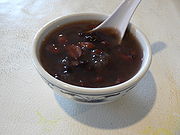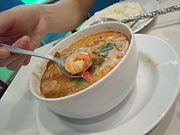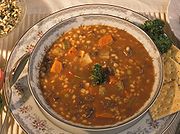
Soup
Background to the schools Wikipedia
This wikipedia selection has been chosen by volunteers helping SOS Children from Wikipedia for this Wikipedia Selection for schools. Child sponsorship helps children one by one http://www.sponsor-a-child.org.uk/.
Soup is a food that is made by combining ingredients such as meat and vegetables with stock, juice, water or another liquid. Hot soups are additionally characterized by boiling solid ingredients in liquids in a pot until the flavours are extracted, forming a broth. Traditionally, soups are classified into two main groups: clear soups and thick soups. The established French classifications of clear soups are bouillon and consommé. Thick soups are classified depending upon the type of thickening agent used: purées are vegetable soups thickened with starch; bisques are made from puréed shellfish or vegetables thickened with cream; cream soups may be thickened with béchamel sauce; and veloutés are thickened with eggs, butter and cream. Other ingredients commonly used to thicken soups and broths include rice, flour and grains.
Soups are similar to stews, and in some cases there may not be a clear distinction between the two. Generally though, soups have more liquid than stews.
History
One of the first types of soups can be dated to about 6,000 B.C. Boiling was not a common cooking technique until the invention of waterproof containers (which probably came in the form of pouches made of clay or animal skin) about 9,000 years ago. Soup can be made out of broth or a form of liquid.
The word soup comes from French soupe ("soup", "broth"), which comes through Vulgar Latin suppa ("bread soaked in broth") from a Germanic source, from which also comes the word " sop", a piece of bread used to soak up soup or a thick stew.
The word restaurant (meaning "[something] restoring") was first used in France in the 16th century, to describe a highly concentrated, inexpensive soup, sold by street vendors, that was advertised as an antidote to physical exhaustion. In 1765, a Parisian entrepreneur opened a shop specializing in such soups. This prompted the use of the modern word restaurant to describe the shops.
In America, the first colonial cookbook was published by William Parks in Williamsburg, Virginia, in 1742, based on Eliza Smith's The Compleat Housewife; or Accomplished Gentlewoman's Companion and it included several recipes for soups and bisques. A 1772 cookbook, The Frugal Housewife, contained an entire chapter on the topic. English cooking dominated early colonial cooking; but as new immigrants arrived from other countries, other national soups gained popularity. In particular, German immigrants living in Pennsylvania were famous for their potato soups. In 1794, Jean Baptiste Gilbert Payplat dis Julien, a refugee from the French Revolution, opened an eating establishment in Boston called The Restorator, and became known as "The Prince of Soups". The first American cooking pamphlet dedicated to soup recipes was written in 1882 by Emma Ewing: Soups and Soup Making.
Portable soup was devised in the 18th century by boiling seasoned meat until a thick, resinous syrup was left that could be dried and stored for months at a time. The Japanese miso is an example of a concentrated soup paste.
Commercial soup products
Commercial soup became popular with the invention of canning in the 19th century, and today a great variety of canned and dried soups are on the market.
Canned soup
Dr. John T. Dorrance, a chemist with the Campbell Soup Company, invented condensed soup in 1897. Today, Campbell's Tomato, Cream of Mushroom, and Chicken Noodle Soup are three of the most popular soups in America. Americans consume approximately 2.5 billion bowls of these three soups alone each year. Canned Italian-style soups, such as minestrone or Italian wedding, are also popular, and are sold by brands including Progresso and Cento Fine Foods.
Canned soup can be condensed, in which case it is prepared by adding water (or sometimes milk), or it can be "ready-to-eat," meaning that no additional liquid is needed before eating. Canned soup (condensed with liquid added, or "ready-to-eat") can be prepared by heating in a pan, on the stovetop or in the microwave. Such soups can be used as a base for homemade soups, with the consumer adding anything from a few vegetables to eggs, vegetables, cream or pasta.
Condensing soup allows soup to be packaged into a smaller can and sold at a lower price than other canned soups. The soup is usually doubled in volume by adding a "can full" of water or milk (about 10 ounces).
Since the 1990s, the canned soup market has burgeoned with soups marketed as "ready-to-eat," which require no additional liquid to prepare. Microwaveable bowls have expanded the ready-to-eat canned soup market even more, offering convenience (especially in workplaces) and are popular lunch items.
Dried soup
Asian-style soup mixes containing ramen noodles are marketed by Western and Asian manufacturers as an inexpensive instant meal, requiring only hot water for preparation.
In terms of Western-style cuisine, vegetable, chicken base, potato, pasta and cheese soups are also available in dry mix form, ready to be served by adding hot water and sometimes fresh ingredients such as meat or vegetables.
Nutritional developments
- Salt - In response to concern over the health effects of excessive salt intake, some soup manufacturers have introduced reduced-salt versions of popular soups.
- Trans fat - Concern over coronary heart disease has led some soup manufacturers to eliminate trans fats from their soups.
Types of soup
Dessert soups
- Ginataan, Filipino soup made from coconut milk, milk, fruits and tapioca pearls, served hot or cold
- Oshiruko, a Japanese azuki bean soup
- Tong sui, a collective term for Chinese sweet soups
Fruit soups
Fruit soups are served warm or cold depending on the recipe. Many recipes are for cold soups served when fruit is in season during hot weather. Some, like Norwegian fruktsuppe, may be served warm and rely on dried fruit, such as raisins and prunes and so could be made in any season. Fruit soups may include milk or cream, sweet or savoury dumplings, spices, or alcoholic beverages, such as brandy or champagne. Cherry soup is made with table wine and/or port. Starch, particularly potato starch, is used to thicken fruit soups, to make kisel.
Cold and warm fruit soups are common in Scandinavian, Baltic and Eastern European cuisines, while hot fruit soups with meat appear in Middle Eastern, Central Asian and Chinese cuisines. Cold fruit soups include krentjebrij.
Fruit soups are uncommon or absent in the cuisines of the Americas, Africa and Western Europe. They are also not seen in Japan, Southeast Asia or Oceania. The exception is cold fruit soups that are savory rather than (or in addition to) sweet. For example:
- Winter melon soup is a Chinese soup, usually with a chicken stock base. It is a savory soup, often including other vegetables and mushrooms. Technically, the winter melon is a fruit, since it is a seed bearing body, but in practical use, it is a vegetable. Winter melon soup is often presented as a whole winter melon, filled with stock, vegetables and meat, that has been steamed for hours. The skin is decoratively cut, so that what is presented is a decorative centerpiece, smaller than a medicine ball, larger than a soccer ball, filled with soup. The flesh of the melon is scooped out with the soup.
Cold soups
Cold soups are a particular variation on the traditional soup, wherein the temperature when served is kept at or below room temperature. They may be sweet or savory. In summer, sweet cold soups can form part of a dessert tray. An example of a savory chilled soup is gazpacho, a chilled vegetable-based soup originating from Spain.
Asian soups
A feature of East Asian soups not normally found in Western cuisine is the use of tofu in soups. Many traditional East Asian soups are typically broths, clear soups, or starch thickened soups.
Traditional regional soups
- Ajiaco is a chicken soup from Colombia.
- Avgolemono is a Greek chicken soup with lemon and egg.
- Bajajou, a soup of Slovakian origin, is made with boiled beef intestines, chicken egg, onion and rice.
- Bird's nest soup is a delicacy in Chinese cuisine.
- Bisque is a thick, creamy, highly-seasoned soup, classically of pureed crustaceans, of French origin.
- Borscht is a beet-vegetable soup originally from Ukraine and Russia.
- Bouillabaisse, a fish soup from Marseille, is also made in other Mediterranean regions; in Catalonia it is called bullebesa.
- Bourou-bourou is a vegetable and pasta soup from the island of Corfu, Greece.
- Caldo verde is a Portuguese minced kale soup
- Callaloo is a thick, creamy soup made with okra and, often, crab meat from Trinidad and Tobago
- Canh chua ( sour soup) made with rice, fish, various vegetables, and in some cases pineapple is from Vietnam.
- Canja de galinha is a Portuguese soup of chicken, rice and lemon.
- Cazuelais a Chilean soup of medium thick flavoured stock obtained from cooking several kinds of meats and vegetables mixed together.
- Clam chowder is found in two major types, New England clam chowder, made with potatoes and cream, and Manhattan clam chowder, made with a tomato base.
- Cock-a-leekie soup is leek and potato soup made with chicken stock, from Scotland.
- Cullen Skink, also from Scotland, is a fish soup made with smoked haddock, potatoes, onions and cream.
- Egg drop soup, a savory Chinese soup, is made by adding already-beaten eggs into boiling water or broth.
- Etrog, a fruit soup made from the citron used in Jewish Ritual at the feast of Succoth, is eaten by Ashkenazi Jews at Tu Bishvat.
- Faki soupa is a Greek lentil soup, with carrots, olive oil, herbs and possibly tomato sauce or vinegar.
- Fanesca is a traditional cod soup from Ecuador.
- Fasolada is a traditional Greek bean soup.
- French onion soup is a clear soup made with beef broth and sauteed (caramelized) onions.
- Fufu and egusi soup, a traditional soup from Nigeria, is made with vegetables, meat, fish, and balls of ground melon seed.
- Gazpacho (from Spain and Portugal) is a savory soup based on tomato.
- Goulash is a Hungarian soup of beef, paprika and onion.
- Gumbo, a traditional Creole soup from the Southern United States, is thickened with okra pods, roux and sometimes filé powder.
- Halászlé (fisherman's soup), a very hot and spicy Hungarian river fish soup, is made with hot paprika.
- Íslensk Kjötsúpa is a traditional Icelandic meat soup made with lamb and vegetables.
- Kharchois a Georgian soup of lamb, rice, vegetables and a highly spiced boullion.
- Lagman, a tradition in Uzbekistan, is made with pasta, vegetables, ground lamb and numerous spices.
- Lan Sikik is a Thai soup made with noodles, dried fish and tomato extract.
- Leek soup, a simple soup made from leeks, is popular in Wales during Saint David's Day.
- Lentil soup is popular in Middle Eastern and Mediterranean cuisines.
- London particular is a thick soup of pureed (dry or split) peas and ham from England; purportedly it is named after the thick fogs of 19th century London.
- Maryland crab soup is made of vegetables, blue crab meat, and Old Bay Seasoning in a tomato base, from Maryland.
- Menudo, a traditional Mexican soup, is with tripe (usually beef) and hominy.
- Michigan bean soup has been a staple for over a hundred years in the U.S. Senate dining room.
- Minestrone is an Italian vegetable soup.
- Miso soup is made from fish broth and fermented soy in Japan.
- Mulligatawny is an Anglo-Indian curried soup.
- Nässelsoppa ( nettle soup), made with stinging nettles, and traditionally eaten with hard boiled egg halves, is considered a spring delicacy in Sweden.
- Noodle soup is the common name for a diverse collection of soups with varied ingredients, including (obviously) noodles.
- Patsás is made with tripe in Greece.
- Philadelphia pepper pot soup, a Philadelphia specialty, is traditionally made with tripe.
- Phở is Vietnamese beef/chicken soup with scallions, welsh onion, cherred ginger, wild coriander ( Eryngium foetidum), basil, cinnamon, star anise, clove and black cardamom.
- Psarosoupa, a Greek fish soup, is made in various versions with a variety of fish types.
- Revithia is a Greek chickpea soup.
- Sancocho is chicken soup with vegetables in Latin America.
- Scotch broth is made from mutton or lamb, barley and root vegetables.
- Shchav, a sorrel soup in Polish, Russian and Yiddish cuisines, is sour from the sorrel.
- She-crab soup, from Charleston, South Carolina, is a creamy soup made with blue crab meat and crab roe.
- Sinigang, from the Philippines, is a clear sour soup made from tamarind paste and meat, fish, or vegetables.
- Snert (erwtensoep), a thick pea soup, is eaten in the Netherlands as a winter dish, and is traditionally served with sliced sausage.
- Solyanka is another cabbage soup from Russia.
- Soto, a traditional Indonesian soup made with turmeric, galangal, etc., usually contains either beef or chicken.
- Split peas soup, a thick soup made in the Caribbean from split peas (chickpeas or garbanzos), usually includes "ground provision" vegetable staples and some type of meat.
- Tarator is a Bulgarian cold soup made from yogurt and cucumbers.
- Tomato soup comes in several varieties, with tomatoes in common.
- Tom yumis the name for two similar hot and sour soups with fragrant herbs from Laos and Thailand.
- Tarhana soup, from Turkish cuisine is made with fermented grains and yoghurt.
- Vichyssoise, a French-style soup invented by a French chef at the Ritz Hotel in New York City, is a cold purée of potatoes, leeks, and cream.
- Waterzooi is a Belgian fish soup.
- Yukgaejang, a Korean spicy beef soup, also includes vegetables.
- Żurek, a Polish sour rye soup with sausages, is often served in a bowl made of bread.
Soup as a figure of speech
In the English language, the word "soup" has developed several uses in phrase.
- Alphabet soup, a term often used to describe a large number of acronyms used by an administration, has its roots in a common tomato-based soup containing pasta shaped in the letters of the alphabet.
- Primordial soup is a term used to describe the organic mixture leading to the development of life.
- A soup kitchen is a place that serves prepared food of any kind to the homeless.
- Pea soup describes a thick or dense fog.
- "Soup legs" is an informal or slang term used by athletes to describe fatigue or exhaustion.
- " Stone soup" is a popular children's fable.
- Duck soup is a term to describe a task that is particularly easy.
- Word soup refers to any collection of words that is ostensibly incomprehensible.
- Tag soup further refers to poorly coded HTML.
- Soup Fire! can be used an expression of surprise.
- Soupe du jour is French for "soup of the day." Sometimes used as a metaphor for anything currently trendy or fashionable.
- Soup to nuts is an American English idiom conveying the meaning "from beginning to end" (see: full course dinner).
- "Soup's on!" or "Soup's up!" is a common phrase used to say, "Dinner's ready."
- Soup Sandwich is a denigrative U.S. military slang term, typically used to admonish a trooper for poor work or shoddy appearance. The term comes from the concept that a sandwich made out of soup would be a sloppy mess.
- To soup something up is to improve it, or increase its power (most often used of cars, aeroplanes, and the like)- possibly from "supercharge".
In popular culture
- The Soup Nazi is a fictional character from Seinfeld who makes fantastic soup but has very strict ordering procedures.
- In the horror film, The Exorcist, Regan MacNeil vomits pea soup while possessed.
- "Duck Soup" is the name of a famous comedy done by the Marx Brothers.










